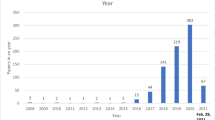Abstract
With the rapid development of computer technology and artificial intelligence today, human–computer interaction based solely on computer software operations is far from being able to meet human requirements for computer use. People are looking forward to a more convenient and fast human–computer interface. This paper studies the expression dynamic capture and 3D animation generation methods based on deep learning. For facial expression dynamic capture, this paper proposes a facial feature extraction algorithm based on deep learning and uses SVM technology for feature classification. For 3D animation, C++ and OpenGL are used for rendering simulation. The experimental results show that the face detection algorithm proposed in this paper has good performance in both accuracy and speed. It can realize real-time detection of face regions in video images.










Similar content being viewed by others
References
Takahashi Y, Murata S, Idei H et al (2021) Neural network modeling of altered facial expression recognition in autism spectrum disorders based on predictive processing framework. Sci Rep 11(1):1–9
Hussein HI, Dino HI, Mstafa RJ et al (2022) Person-independent facial expression recognition based on the fusion of HOG descriptor and cuttlefish algorithm. Multimed Tools Appl 81(8):11563–11586
Uono S, Sato W, Kochiyama T et al (2022) The structural neural correlates of atypical facial expression recognition in autism spectrum disorder. Brain Imaging Behav 16(3):1428–1440
Porter-Vignola E, Booij L, Bossé-Chartier G et al (2021) Emotional facial expression recognition and depression in adolescent girls: associations with clinical features. Psychiat Res 298(8):113777–113795
Noyes E, Davis JP, Petrov N et al (2021) The effect of face masks and sunglasses on identity and expression recognition with super-recognizers and typical observers. R Soc Open Sci 8(3):35–46
Zhuang M, Yin L, Wang Y et al (2021) Highly robust and wearable facial expression recognition via deep-learning-assisted. Soft Epiderm Electr Res 2021(3):1–14
Li Y, Huang X, Zhao G (2021) Joint local and global information learning with single apex frame detection for micro-expression recognition. IEEE Trans Image Process 30(14):249–263
Indira D, Sumalatha L, Markapudi BR (2021) Multi facial expression recognition (MFER) for identifying customer satisfaction on products using deep CNN and Haar Cascade classifier. IOP Conf Ser Mater Sci Eng 1074(1):012033
Bah I, Yu X (2022) Facial expression recognition using adapted residual based deep neural network. Intell Robot 2(1):72–88
Chen, Hua Y, Hao Y, et al. 3D product display based on inventor animation design. Instrumentation, 2020, 7(01):35–43
Dong Y, Li J (2017) Recent progresses in deep learning based acoustic models. IEEE/CAA J Automatica Sinica 4(03):396–409
Schirrmeister RT, Gemein L, Eggensperger K et al (2017) Deep learning with convolutional neural networks for decoding and visualization of EEG pathology. Hum Brain Mapp 38(11):5391–5420
Tom Y, Devamanyu H, Soujanya P et al (2018) Recent trends in deep learning based natural language processing. IEEE Comput Intell Mag 13(3):55–75
Zhang X, Yin G, Qi N (2019) Research on high-resolution improved projection 3D localization algorithm and precision assembly of parts based on virtual reality. Neural Comput Appl 31:103–111
Codella N, Nguyen QB, Pankanti S et al (2017) Deep learning ensembles for melanoma recognition in dermoscopy images. Ibm J Res Dev 61(4):1–15
Rawlani R, Qureshi H, Rawlani V et al (2019) Volumetric changes of the mid and lower face with animation and the standardization of three-dimensional facial imaging. Plast Reconstr Surg 143(1):76–85
Ruhland K, Prasad M, Mcdonnell R (2017) Data-driven approach to synthesizing facial animation using motion capture. IEEE Comput Graph Appl 37(4):30–41
Yao CY, Chen KY, Guo HN et al (2017) Resolution independent real-time vector-embedded mesh for animation. IEEE Trans Circuits Syst Video Technol 27(99):1974–1986
Demir R, Baysal A (2020) Three-dimensional evaluation of smile characteristics in subjects with increased vertical facial dimensions. Am J Orthod Dentofac Orthop 157(6):773–782
Chen Y, Lin Z, Xing Z et al (2017) Deep learning-based classification of hyperspectral data. IEEE J Sel Top Appl Earth Observ Remote Sens 7(6):2094–2107
Shen D, Wu G, Suk HI (2017) Deep learning in medical image analysis. Annu Rev Biomed Eng 19(1):221–248
Kermany DS, Goldbaum M, CaI W et al (2018) Identifying medical diagnoses and treatable diseases by image-based deep learning. Cell 172(5):1122-1131.e9
Author information
Authors and Affiliations
Corresponding author
Ethics declarations
Conflict of interest
These no potential competing interests in our paper. And all authors have seen the manuscript and approved to submit to your journal. We confirm that the content of the manuscript has not been published or submitted for publication elsewhere.
Data Availability Statement
Data sharing not applicable to this article as no datasets were generated or analysed during the current study.
Additional information
Publisher's Note
Springer Nature remains neutral with regard to jurisdictional claims in published maps and institutional affiliations.
Rights and permissions
Springer Nature or its licensor holds exclusive rights to this article under a publishing agreement with the author(s) or other rightsholder(s); author self-archiving of the accepted manuscript version of this article is solely governed by the terms of such publishing agreement and applicable law.
About this article
Cite this article
Wang, B., Shi, Y. Expression dynamic capture and 3D animation generation method based on deep learning. Neural Comput & Applic 35, 8797–8808 (2023). https://doi.org/10.1007/s00521-022-07644-0
Received:
Accepted:
Published:
Issue Date:
DOI: https://doi.org/10.1007/s00521-022-07644-0




